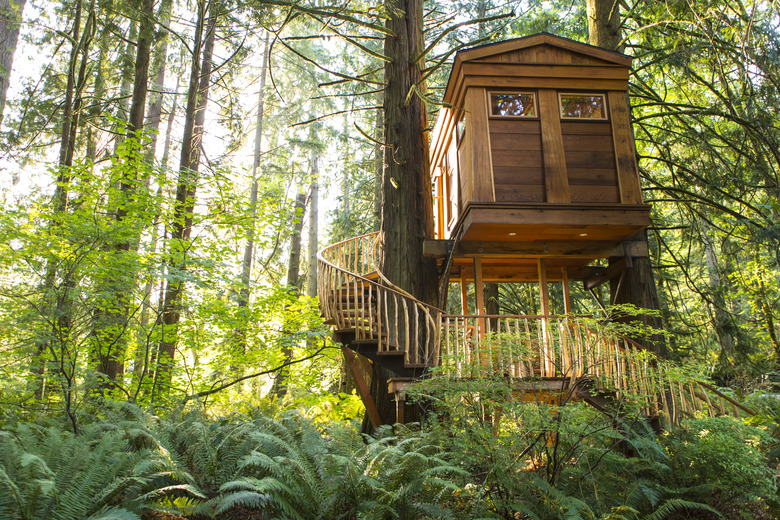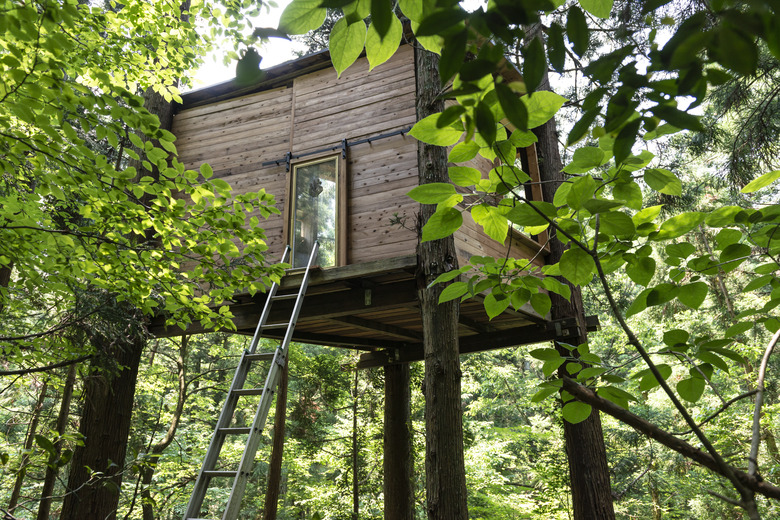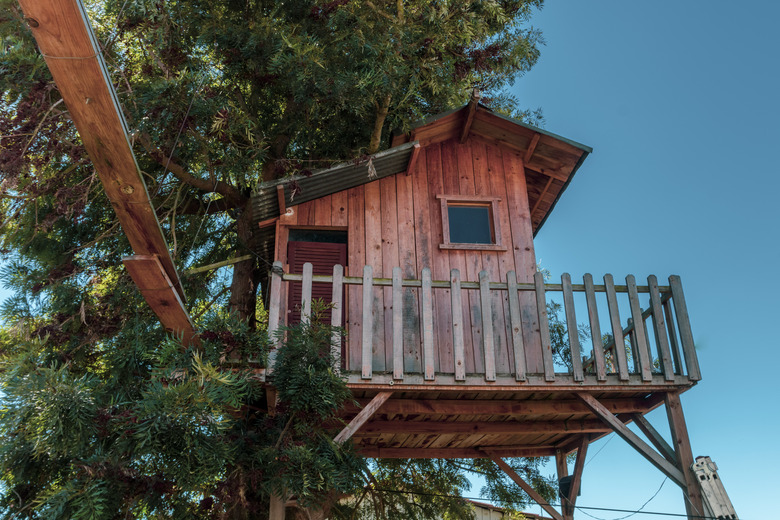Treehouse Safety Rules And Recommendations
We may receive a commission on purchases made from links.
Treehouse safety should be at the top of your priorities list as you prepare to perch a playhouse for your children or a getaway for yourself in a tree. Nationwide Children's Hospital reports that some 2,800 children are treated in emergency rooms every year for treehouse-related accidents, and most of their injuries are from falls. Placing a playhouse high in a tree isn't just potentially dangerous for the kids who use it, though — it's also risky for the builders who build it. They put themselves in harm's way by working from ladders and using power tools in precarious situations.
Construction of a treehouse calls for enhanced workplace safety measures as well as a treehouse design, building techniques and materials that guarantee safety for people using the treehouse. If you build your treehouse with safety in mind and inspect it regularly, everyone using it will be able to breathe easier, and they'll enjoy your creation that much more.
Find a Safe Tree
Find a Safe Tree
Construction of a safe treehouse begins with choosing a safe tree. It must be in a safe location that is far from traffic, and the area around it must be free from hazards, like above-ground tree roots, thorny plants and debris such as broken glass and scrap metal. If you plan to use more than one tree or more than one branch on the same tree to support your new treehouse, look for these characteristics:
- Tree trunks should be at least 12 inches and supporting branches at least 8 inches in diameter.
- There should be no power lines anywhere near the tree.
- Support branches should extend out from the trunk at close to 90-degree angles for maximum strength.
If you have any doubts about the tree in question, contact a good local arborist who will be able to give you their expert opinion on the strength of the tree and the feasibility of your project.
Make a Safe Treehouse Design
Make a Safe Treehouse Design
Keeping in mind that the bulk of accidents that happen to children using treehouses involve falls, build your treehouse as close to the ground as possible and definitely no higher than 10 feet, which is the height of a regulation basketball hoop. The treehouse platform should have a railing with a minimum height of 36 inches and vertical balusters separated by no more than 4 inches, as required by code for all decks. Avoid horizontal balusters on which kids of all ages can climb. If you design the treehouse such that the walls are built around the perimeter of the platform and they are solid with no low windows, that's even better, but you should still build a railing around the door and any landing spaces.
It's important to provide easy access to the treehouse platform. A climbing rope or a rope ladder may be a charming touch, but it's also a strangulation hazard and isn't suitable for small children. However, if you build a stairway or a ladder with a 60- to 70-degree slope, a rope ladder can be a fun item for older kids as long as you make it from strong rope, check it regularly by giving it a good pull from the ground and establish a reliable way to prevent young children from using it. Be sure to provide ample space with a wall or railing around it at the top of the ladder or stairway for a landing.
If you're like most homeowners, you'll probably want to make the treehouse from wood, which is the easiest building material to use and looks best in a tree. Sand all handholds, such as railings and door pulls, to eliminate splinters, and avoid snagging hazards by checking periodically for loose or lifting fasteners. Use self-countersinking screws to ensure the heads are sunk below the wood. For lag screws, bolts and other large fasteners, drill countersink holes so the heads of the hardware are recessed into the wood.
Design Safe Doors and Windows
Design Safe Doors and Windows
Doors and windows in a treehouse building can be potentially dangerous, especially for kids, unless you design them properly. You can leave doorways open as long as you provide the requisite railing around the area outside each one, but if you do install doors, make sure they open into the treehouse and not onto the platform, where they could open suddenly and force someone over the railing. If you choose to cover windows, use clear acrylic plastic or — even better — thick, flexible plastic tabletop covering material, which is completely crackproof. Make sure the bottoms of the windows are at least 36 inches above the platform whether you cover them with plastic or not.
Build a Safe Treehouse
Build a Safe Treehouse
A do-it-yourself backyard treehouse is a more complicated project than other DIY projects because it involves building onto a tree, which is alive, growing and vulnerable to injury. Moreover, trees move constantly in the wind, and although the movements are imperceptible near the ground, they generate enormous forces that can make a treehouse dangerous if it isn't properly attached and supported. Even if you're handy with woodworking tools and methods, it's advisable for safety and the longevity of the treehouse to have an experienced treehouse builder walk through the design process with you to determine the best support methods for your particular situation.
Treehouse supports should never be attached to the trunk of the tree or a limb with regular wood screws or nails. Besides the fact that conventional fasteners aren't long or bulky enough to provide reliable support, you have to use more than one, and trees don't like to have fasteners driven into them spaced closely together. They respond by compartmentalizing the area around the fasteners and cutting it off, resulting in an area of deadwood that loses its ability to hold the fasteners. Supports should always be attached with a single bolt, and when you attach more than one support, the bolts should be separated by at least 12 inches both horizontally and vertically.
Use fasteners large enough to handle the loads. When you attach fixed supports with lag screws, the screws should have a minimum diameter of 3/4 inches, but 1 and 1 1/4-inch ones are recommended. When attaching a support to two trees or two branches on the same tree, use flexible connectors, such as treehouse attachment bolts (TABs) that allow the support to move independently of the tree. When constructing the platform deck around a tree trunk, leaving a 2-inch gap to allow the trunk to grow will prevent the deck from buckling, and it will protect the tree.
Work Safely Around Trees
Work Safely Around Trees
Treehouse safety applies just as much to the process of building the treehouse as it does to the finished product, and even more than a conventional project, a treehouse project calls for safety gear and precautions. Working from a ladder is hazardous, as is working while perched on a tree branch, so experienced treehouse builders do as much construction as they can on the ground and hoist preassembled sections into place with a pulley. They keep the work area clean to prevent slips and falls, and they make sure their ladders are stable before climbing on them. When the ground isn't level enough to stabilize a ladder, they erect scaffolding and work from that.
Treehouse Pros recommend using the following safety gear when building a treehouse:
- Safety boots with steel toes to protect against stray hammers and saws.
- Protective gloves with grip pads.
- Goggles or some other type of protective eyewear.
- A high-visibility safety jacket that allows you to be easily found should something happen.
- A hard hat to protect your head from falling branches and other objects, such as acorns.
- A safety harness if you're working any higher than 10 feet off the ground.
- A dust mask when you're sanding the railings and other wood parts of the treehouse.
In addition, pay attention to your working environment. If a storm is coming, put your tools away and wait for it to pass, or go home and come back the next day. If you're working in direct sun, make sure you drink enough water, and if you start to feel dizzy, take a break in the shade until you feel better. Following these safety precautions will help ensure you're around to enjoy your children enjoying the treehouse.


